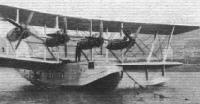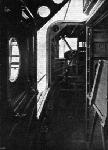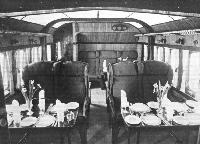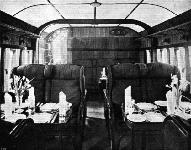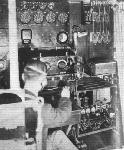Short S.17 Kent и L.17 Scylla
По ряду причин, отразившихся на перевозках авиакомпании "Imperial Airways" в Каир, компания заключила контракт с "Short Brothers" на постройку трех четырехмоторных летающих лодок. Эти лодки должны были иметь достаточную дальность полета, комфортабельный салон для 15 пассажиров и доставлять авиапочту. В качестве основы силовой установки был выбран двигатель Bristol Jupiter XFBM мощностью 555 л. с.
Самолет, получивший обозначение S.17 Kent, поступил в эксплуатацию в мае 1931 года. S.17 интенсивно использовались на авиалинии, каждый имел налет более 6437 км в неделю. Один самолет был потерян в августе 1936 года, когда совершил неудачную посадку и затонул, другой был подожжен в ноябре 1935 года на аэродроме Бриндизи, а третий уцелел и был списан в июне 1938 года.
<...>
Показать полностьюShow all
Flight, October 1930
4-ENGINED SHORT FLYING BOAT
Bristol "Jupiter" Engines
GENERALLY speaking the design of the 4-engined flying boat which Short Brothers have designed and are now building for operation by Imperial Airways on the Mediterranean section of the Empire air routes is similar to the famous 3-engined "Calcutta" which has been in use for a period of years. Such design modifications as have been made are of a minor character only, and are the result of the experience gained with the older type. Apart from the fact that the new machines will be fitted with four instead of three "Jupiter" engines, the new boats differ chiefly in that the whole of the planing bottom, up to a little above the waterline, will be planked with stainless steel. No matter how the design of a flying boat hull is simplified, it is .impossible entirely to avoid awkward corners in out-of-the way places in the hull, and externally the inspection of the underwater portion necessitates beaching of the boat. Moreover, the flying boat of the future must be capable of being moored out for very long periods, and in fact should never be hauled up except when a thorough overhaul is to be carried out. The effect which the use of stainless steel for the planking of the underwater portion of the hull will have on the operational economy of the new boats cannot but be very great, and the introduction of this material into a commercial flying boat is to be very heartily welcomed. Of its success there can be little doubt. Stainless steel has already been used on certain portions of service types of flying boats, and any difficulties there may have been in the handling and application of the material will have been overcome by now. At the present time stainless steel is somewhat costly, it is true, but the life of a flying boat hull should be so greatly increased by its use that the extra cost is probably well worth while. And in any case, the more extensive use of stainless steel will undoubtedly in time lead to a considerable reduction in price.
If one examines the main data given in the table on this page it is found that the new 4-engined flying boats will (according to present estimates, which may be slightly modified when the first machine is completed) have a gross weight of 30,310 lb. and a tare weight of 17,900 lb., giving a ratio of gross to tare weight of 1-693. In other words, the disposable load is 69 per cent, of the tare weight of the machine, a figure which must be regarded as good for a flying boat with a gross weight of 13 1/2 tons, especially as it is achieved with wing loadings and power loadings which must be regarded as very moderate. And it is estimated that with these loadings the machine will cruise at 100 m.p.h. with the engines running at 90 per cent, of their normal full power revolutions. The tare weight given in the table includes cabin equipment, but does not include such items as wireless equipment, electrical equipment, certain instruments, and marine equipment, fire extinguishers, domestic water supply, etc., nor, of course the weight of the crew and their gear. All these items amount to 1,560 lb., and as the machine is incomplete without them, the figure of 1,560 1b. should either be added to the tare weight or subtracted from the variable load. If that is done it is found that the variable load amounts to 10,850 lb., or 4-9 lb./h.p., based on normal full power.
Obviously the variable load may be divided in any proportion desired between fuel and pay load, according to the range it is necessary to have. The tankage provided will allow for 720 gallons of petrol and 54 gallons of oil, which is sufficient for 8 hours' duration, or a range in still air of about 800 miles at a cruising speed of 100 m.p.h. The weight of fuel and oil (full tanks) would be 6,160 lb., and would still leave a pay load of 4,690 lb. Normally it is intended that the tanks should not be quite full, but should hold sufficient for 5 hours' flight, or a fuel and oil weight of 3,860 lb. This would leave a pay load of 6,990 lb., or 3-15 lb./h.p. based on normal full power. It is intended that this pay load should be divided equally between mails and passengers. Actually 3,550 lb. for mails, and 3,440 lb. for passengers. The latter figure corresponds to 16 passengers at 215 lb. each, a weight which will leave each passenger (except the unusually heavy) an ample allowance for luggage.
It is of interest to point out that if the whole of the variable load were in the form of petrol and oil, the duration would be something like 14 hours. This figure does not take into account the weight of the extra tanks that would have to be fitted, but on the other hand, if the total available load were used for fuel, there would be no need for passenger cabin equipment, the weight of which could be used for tanks.
In order to facilitate an estimate of the relationship between pay load and duration, or range, of the 4-engined Short flying boat we have prepared the graph published on p. 1132. It is not claimed that this chart will give very great accuracy, since in the calculations on which it is based no account has been taken, for long ranges, of the effect of the gradual lightening due to the fuel being consumed. But it is thought that the graph will assist in making very readily an approximate estimate of the pay load on route stages of various lengths.
As already mentioned, the main difference in general design between the "Calcutta" and the new flying boats will be the use of four instead of three engines. This is probably a stipulation made by Imperial Airways, Ltd., in order further to reduce the likelihood of forced landings. The new four-engined flying boats have a gross weight considerably greater than that of the "Calcutta," but the power loading will be almost exactly the same. Therefore the increase in power loading when one engine is out of action will be smaller in the new boats than in the "Calcutta." More explicitly, when one engine stops in the "Calcutta" the power loading is increased to 3/2 = 1-5 times its previous value, in the new boats the increase will, of course, be in the ratio 4/3 or 1-33 times the original figure. Thus in case of failure of one engine, the remaining three will not have to be called upon to give as much extra power as in the “Calcutta,” and the likelihood of another engine giving trouble will, therefore, presumably be correspondingly reduced. In fact, the power loading of the remaining three engines seems to be such that the machine will probably be able to continue its flight at a slightly reduced cruising speed, without speeding up the engines.
It will probably come as something of a surprise to many to find that, after achieving an outstanding success with their four-engined "Singapore II," Short Brothers have chosen the 4 in line arrangement of the engines in the new commercial flying boats. How far this arrangement is the choice of Short's designers, and how far they have been influenced by the requirements of the future operators of the machines, we have no means of knowing. The decision cannot have been an easy one. On the one hand there is the probability of reduced drag with the engines arranged in tandem pairs, and the smaller yawing moment of the engines placed closer in towards the centre. On the other there is the fact that the wing stresses are reduced by placing the engines in line abreast, while the difficulty of cooling the rear engines does not arise, nor the power loss likely to be encountered when one of the front engines stops and the "overpitched" propeller of the rear engine works in air of less relative velocity. In the "Singapore II" Rolls-Royce water cooled engines are used, and the question of cooling the rear engines presents no particular difficulty. But with air-cooled engines the "pusher" has not hitherto been the subject of very much experimentation in this country. This may actually have been the deciding factor in settling the engine arrangement on the new four-engined Short flying boats.
The actual engine mountings in the new machines are evidently an adaptation of those used on the "Singapore II," the changes being those necessitated by the fact that the engines are radials, and placed singly instead of in tandem pairs. On the "Singapore II" this type of engine support was found to give excellent results, being light, strong and simple. In the new machine the engine nacelles are carefully streamlined and will doubtless assist materially in reducing the drag to a value which may be no greater than would have been the drag of engines in tandem, for which streamlining could not be carried out.
In actual dimensions the new four-engined flying boats will be considerably larger than the "Calcuttas." For example, the span of the lower wing is approximately the same as the span of the upper wing of the "Calcutta," while the upper wing is of 113 ft. span as against 93 ft. of the "Calcutta." The boat hull, although generally similar in its lines, will also be materially larger, and the extra width of cabin will be utilised by placing the seats in lines of four abreast across the cabin.
Structurally the new machines will, generally speaking, be similar to the "Calcuttas," i.e., the wings will be of the now familiar Short type of construction, with corrugated Duralumin strip box spars and tubular Duralumin ribs, and the hull will show the typical Short features of the transverse frames forming the main members, with the skin or planking doing its share in bearing stresses, while the fore-and-aft stringers are used to stiffen the planking in compression, but are interrupted at the frames. The introduction of stainless steel for planking of the planing bottom is an innovation, and has already been mentioned.
Accommodation
The layout of the accommodation in the hull is so arranged that in the extreme bows there is a compartment containing the mooring equipment, with a hatch in the deck closed by a hinged cover. Aft of the mooring compartment is the large cockpit for the pilots, whose seats are placed side by side, but with a space between to give access to the mooring compartment. Dual controls are provided, and the machine can be flown from either seat. Behind the cockpit is the wireless cabin, which contains, in addition to the wireless equipment, a chart table and other accommodation for the wireless operator-navigator. Aft of his cabin, on the starboard side, is the large mail compartment, which will hold some 3,500 lb. of mails. Behind that is the passenger cabin, with seating accommodation for 16 passengers, the seats being arranged in four rows of four seats each. The cabin has a length of 14 ft., a width of 8 ft. 9 in., and a height from floor to ceiling of 6 ft. 6 in. Aft of the cabin is a lavatory on the starboard side and the steward's compartment, with complete cooking facilities, on the port side. And finally a large luggage compartment is situated aft of the lavatory, with a separate entrance hatch.
The four rows of seats are well spaced out fore and aft so that there is ample leg room. Each side has hinged to its backrest a table for the use of the passenger behind, and footrests are also provided, so that passengers should be able to make prolonged flights without fatigue.
The four engines fitted will be Bristol "Jupiters" of the XI. BM. type, i.e., moderately supercharged to 5,000 ft. in order to give maximum performance at that height. The engines are of the geared type, and should thus give good propeller efficiency.
They are mounted in nacelles of monocoque construction, a type which has been found to be very satisfactory and which possesses great torsional strength. The mounting of the engines has been so designed that they can readily be removed from the aircraft by means of slinging gear carried on board. This will permit of changing engines while the machine is moored on the water. Hand turning gear for starting is provided in each engine nacelle, and a gas starter is installed in one of the nacelles and coupled up to all the engines.
Large petrol tanks are carried in the top centre-section, the total capacity (720 gallons) being sufficient for 8 hours flight at cruising speed. Normally, however, only 450 gallons will be carried. This is sufficient for 5 hours cruising. Petrol is supplied to the engines by direct gravity feed, and the piping is so arranged that any or all engines can be fed from either or all tanks. Connections are fitted to all tanks to enable them to be filled from a central supply, and a refuelling pump is fitted in one of the nacelles for this purpose.
The crew will normally consist of three: chief pilot, second pilot (who will also act as wireless operator and navigator) and steward.
Показать полностьюShow all
Flight, August 1932
The Short "Kent" Class
162,000 Miles Flown Without Trouble
THE great success of the Short "Calcutta" flying boats operated by Imperial Airways led one to expect great things from their successors of the "Kent" class, and the expectations have been fully realised. The "Calcuttas" have by now completed 308,000 miles on the Mediterranean and 186,000 miles on the northern section of the Cairo-Capetown air mail route, or the impressive total of 494,000 miles. In other words, only a little short of half a million miles!
During this time the “Calcuttas" have been subjected to practically continuous open-air exposure, and have quite definitely proved the value of all-metal flying boat construction from the maintenance point of view.
The three flying boats of the "Kent" class, christened by Imperial Airways "Scipio," "Sylvanus" and "Satyrus," have now been in regular use on the Mediterranean section of the London-Cape air route, and have already established a mileage of 162,000 miles without trouble of any kind. When the first machine of the "Kent" class was first flown it was found to be absolutely "right" from the very start, and not a single modification of any importance was required. That is an achievement of which Short Brothers may well be proud, and which confirms the view long held that the Shorts are the finest commercial flying boats in the world.
In the "Kent" class a real endeavour was made to provide comfort for the passengers, and so successful has this been that people who have travelled in them aver that the noise is certainly no more, and perhaps even a little less, than that encountered in a railway train. Coupled with the absence of noise in the "Kent" boats is a cabin in which not only are very comfortable seats provided, but also, and this is less usual, there is plenty of leg and elbow room, as the photograph of the cabin will indicate. And furthermore, the passengers can get up and walk about, so that even on a long journey one experiences no fatigue and no signs of that cramped feeling which results from long flights in a confined space.
The Short "Kent" class of flying boats are fitted with four Bristol "Jupiter" X.F BM engines, developing a normal power of 555 b.h.p. each at 2,000 r.p.m. and 4,000 ft. altitude, and a maximum power of 600 b.h.p. each at 2,200 r.p.m. and 5,000 ft. altitude. The gear reduction to the airscrew has a ratio of 2:1. Four of these engines are fitted in each machine.
With a wing span of 113 ft., an overall length of 78 ft. 5 in. and a wing area of 2,640 sq. ft., the "Kent" has a tare weight of 20,460 lb. fully equipped, while the permissible gross weight is 32,000 lb., giving a ratio of gross to tare weight of 1.563. For the Mediterranean route the machine is equipped to carry 15 passengers, a crew of three and 4,085 lb. of mails. The total pay load, exclusive of crew, is 7,460 lb.
The "Kent" has a maximum speed of 137 m.p.h. at 5,000 ft., a cruising speed of 105 m.p.h. at 5,000 ft. and a minimum flying speed of 60 m.p.h. The rate of climb at sea level is 840 ft./min. and the service ceiling 17,500 ft. The time to take off is 26 seconds.
Показать полностьюShow all
Flight, November 1932
British Aircraft
Short Brothers, Ltd.
Rochester, Kent
LONG before aeroplanes came into being Short Brothers were aeronautical engineers in that in 1897 they had established their own balloon factory. When the work of Wright Brothers and other experimenters began to become known Short Brothers were quick to realise the tremendous possibilities of heavier-than-air craft, and at once set to work to design and construct. Since those early days (1909 or so) they have never looked back, and to-day Short Brothers are among the most esteemed of British aircraft firms. Twin-float seaplanes were among the first Short machines to be constructed, and ever since then the firm has been closely connected with the development of marine aircraft. Of recent years these have been mostly of the flying-boat type, although other types have also been produced.
The "Scipio" Class
Originally known as the "Kent" class, this flying-boat is a four-engined commercial craft with Bristol Jupiter XF. BM engines, and has now taken the place of the "Calcuttas" on the Mediterranean section, the "Calcuttas" having been transferred to the Nile section of the route. In addition to 15 passengers the "Scipio" class carries nearly two tons of mail or freight, and the passenger accommodation is generally admitted to be the most comfortable ever provided. In particular has noise been reduced to a minimum.
A good idea of the magnitude of the Short "Scipio” class can be formed from the following data :-
Length o.a 78 ft. 5 in. (23,9 m.)
Wing span 113 ft. 0 in. (34,5 m.)
Wing area 2,640 sq. ft. (245 m!.)
Tare weight 20,460 lb. (9 300 kg.)
Fuel 3,420 lb. (1 555 kg.)
Pay load and crew 8,120 lb. f3 690 kg.)
Maximum weight 32,000 lb. (14 545 kg.)
Range 450 miles (725 km.)
Ceiling 20,000 ft. (6 100 m.)
Показать полностьюShow all













